#f 94 starfire
Explore tagged Tumblr posts
Text

F-94s of the 101FIS.
Lockheed Starfire first-generation jet powered all-weather day/night interceptor was first operational United States Air Force fighter equipped with an afterburner as well as being the first jet-powered all-weather fighter to enter combat during Korean War.
@CcibChris via X
#f 94 starfire#lockheed aviation#interceptor#aircraft#usaf#aviation#korean war aircraft#cold war aircraft
49 notes
·
View notes
Text


It certainly looked unique. That said, unique 100% does not equal useful.
@Hagdal_H via X
22 notes
·
View notes
Text
F-94 Starfire

84 notes
·
View notes
Text

Lockeed YF-97 Starfire on a test flight - Jan 19 1950
>>> This aircraft was later redesignated as the F-94
40 notes
·
View notes
Link
The article discusses the development and operational history of the Lockheed F-94 Starfire, a Cold War-era Soviet bomber interceptor. Following World War II, the U.S. Air Force sought a replacement for existing fighter aircraft like the Northrop P-61 “Black Widow” to counter the Soviet Tupolev Tu-4 bomber threat. Lockheed developed the F-94 Starfire, an all-weather day/night interceptor, which was the first jet-powered fighter with an afterburner to enter combat during the Korean War. Initially derived from the T-33 “Shooting Star,” the aircraft underwent several upgrades through Models A, B, and C, incorporating advanced radar and transitioning to an all-rocket armament. Notably, the C model played a vital role in the U.S. Air Defense Command's strategy, with 855 units produced, before being replaced by more advanced aircraft like the Northrop F-89 Scorpion. The F-94 also served in various global posts and accrued notable commendations, including the first jet vs. jet nighttime aerial victory during the Korean conflict.
#Lockheed F-94 Starfire#Cold War#United States Air Force#interceptor aircraft#Korean War#Lockheed Aircraft Corporation#radar#afterburner#F-94B#F-94C#Starfire's role#jet engine technology#aerial combat tactics#night fighter capability#operational history#aviation technology advancements#aerospace engineering.
0 notes
Photo


The F-94C Starfire is so underrated as a low key short lived cold war interceptors. National Museum of the United States Air Force.
31 notes
·
View notes
Text
I think these were introduced in 1953. The real life F-94 Starfire was produced from 1949-1954 and would end up only flying until 1959.

436 notes
·
View notes
Text

Lockheed F-94 Starfire -- jet engine and bulbous radar didn't leave any room they had to put the fuel tanks way out on the wingtips...




2 notes
·
View notes
Photo

A group of 319th Fighter-Interceptor Squadron F-94Bs in flight over Suwon Airbase, Korea, 1952
88 notes
·
View notes
Photo


Lockheed F-94 Starfire, America’s first fighter equipped with an afterburner.
19 notes
·
View notes
Text
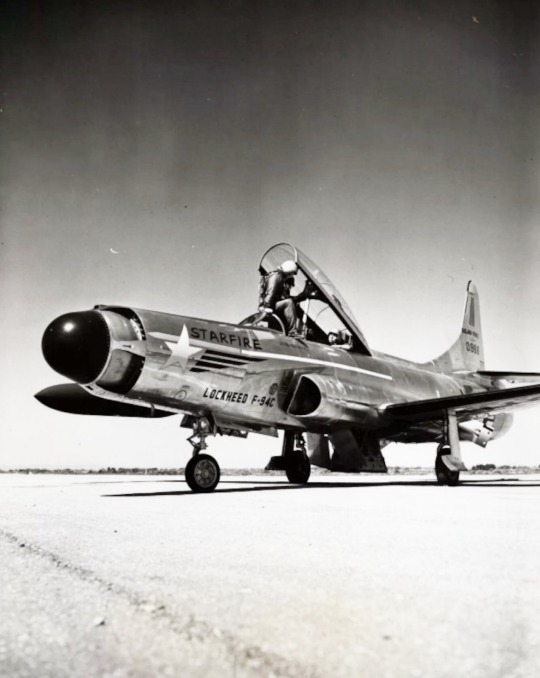
Rocket-nose F-94C Starfire. Firing the Mighty Mouse FFARs blinded the crew with smoke and fire and could cause engine flameout. But does it look cool?
@Tempest_books via X
14 notes
·
View notes
Photo

Yikes!
11 notes
·
View notes
Photo

A "Family Photo" of the full compliment of USAF aircraft in operation in 1956 over Gulf Coast, FL.
From top to bottom of the pic, from left to right are: B-36 Peacemaker, B-47 Stratojet, KC-97 Stratofreighter, RC-121 Warning Star,
Second row: B-52 Stratofortress, C-131 Samaritan, C-119 Flying Boxcar, C-124 Globemaster II, B-57 Canberra, B-66 Destroyer, B-45 Tornado
Third Row: F-94 Starfire, F-89 Scorpion, F-86C Sabre, QF-80A Shooting Star Target, T-33 Shooting Star, F-84 Thunderjet, F-84 Thunderstreak, RF-84 Thunderflash, F-86H Sabre, F-102A Delta Dagger, F-100 Super Sabre.
56 notes
·
View notes
Photo

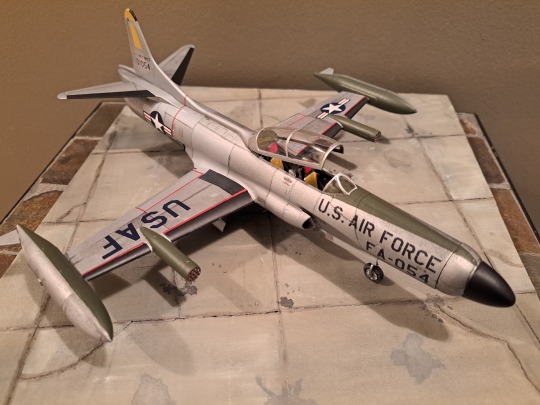
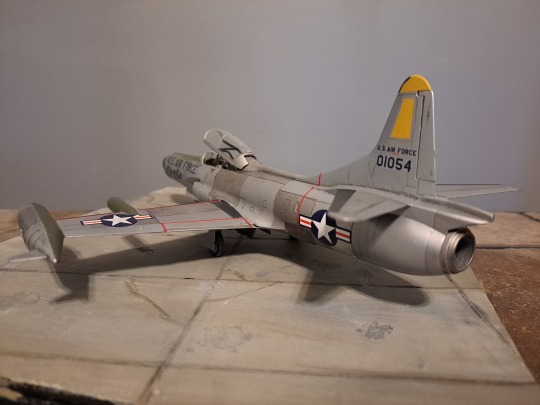


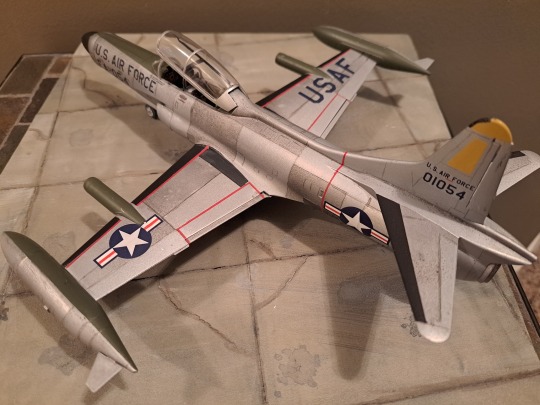
Last build for 2022, the Lockheed F-94C Starfire, Kitty Hawk 1/48. The kit was perplexing to me. I’ve never seen plastic this thin before, but it was great for scale, so kudos. The kit went together really well for a short run kit, really didn’t have any fit issues until I got to the wing roots, which left a huge gap on both sides. So that was a lot of putty and sanding. Onto paint, no problems, but the decals were a bit of a nightmare. They were hollow, if I can explain it. So like, the zeroes for example, were hollow, there was no decal film inside of the letters. So these decals just pulled apart when positioning them. Micro-sol just made them so thin that they split over panel lines. I had to trash the Air Force logo on the nose, and go into the spares box, which thankfully I had. There were also checkers on the tip tanks and rudder, but those crumbled as well. Since F-94 is such a niche build, there really isn’t much for aftermarket decals. In the end, I got them as good as I could and called it done. Despite the struggles, I’m pretty happy with the results, I’ll take them at least.
17 notes
·
View notes
Text
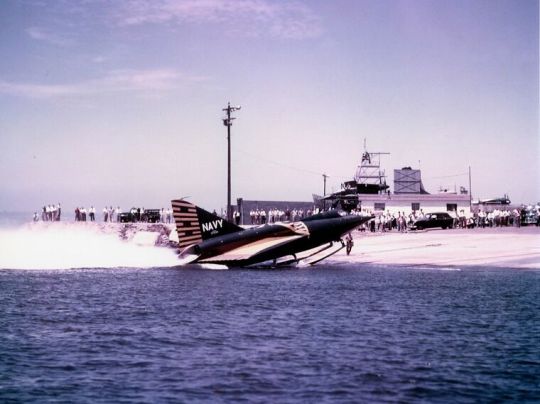
- Convair XF2Y-1 Sea Dart (BuNo 137634) landing on shore. | Photo: US Navy
FLIGHTLINE: 128 - CONVAIR F2Y-1 SEA DART
Designed after WWII, the Sea Dart was the US Navy's first and only supersonic seaplane fighter, though it never saw production.
In the wake of WWII, the US Navy sought a supersonic interceptor aircraft, but doubts about operating jet aircraft, especially supersonic jets, from carriers led to the request for a seaplane interceptor. Convair's design team under Ernest Stout proposed a plane based on the F-102 Delta Dagger, modified with retractable skis.

-Orthograph of the Sea Dart. | Illustration: Convair
In order to reduce the chances of water ingestion, the intakes were moved behind the cockpit, high on the fuselage. The aircraft would sit level in the water, with the wingtips providing floatation for some measure of stability. At 10mph, the skis would extend to an intermediate position, pushing the fuselage out of the water. Between forty-five and fifty-five mph the skis would be fully extended; take off speed would be 145mph. Production aircraft were expected to be fitted with a pair of Westinghouse J46 turbojets, though the prototypes were equipped with J34s instead, as the former were not available. The prototypes were unarmed, but operational F2Ys were to be fitted with four Colt Mk12 20mm cannon and an unspecified number of folding fin aerial rockets; a similar weapons loadout was carried by the F-89 Scorpion and F-94 Starfire.

-Line drawing of the XF2Y-1 prototype with its single ski. | Illustration: blueprints.com
During construction of the XF2Y-1, the contract was altered, eliminating the second prototype and adding 4 service test aircraft (YF2Y) and eight production F2Y models. The prototype was also fitted with a single larger ski compared to the test types. In December 1952 the XF2Y was transported from Convair's San Diego factory to San Diego Bay for testing. On 14 January 1953 it achieved a short flight during taxi testing, with the first official flight occurring on 9 April.

-The XF2Y with a trailer and access ladder. | Photo: US Navy
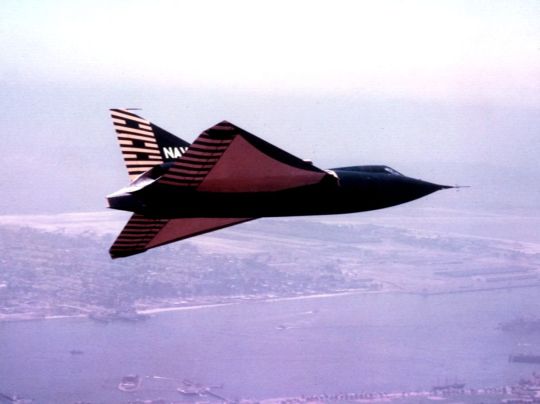
-The XF2Y in flight over San Diego. The yellow markings against the dark blue provided a reference of the aircraft's attitude for engineers. | Photo: US Navy
Flight testing on the XF2Y showed that the plane was (as expected) underpowered with the J34 engines, and was unable to exceed Mach 1. The design, based on the pre-area rulled F-102 fuselage, generated excessive drag, which only exacerbated the issue. In addition, the hydroskis proved to be less effective than hoped, and even with the shock-absorbing oleo legs the aircraft experienced jarring vibrations during takeoffs and landings. Engineers attempted to correct the flaws by refining the ski design, switching to two skis, removing the beaching wheels, and changing the oleo legs, but the vibration issue was never fully solved.
With the cancellation of the second XF2Y, the first two YF2Y test types were fitted with J46s engines and began their test program in 1954. Unfortunately, the J46 proved to also be underpowered, and the Sea Dart was still unable to exceed Mach 1 in level flight. That said, the aircraft did go supersonic on several flights by executing a shallow dive, making it the sole seaplane to break the sound barrier. Tragedy struck on 4 November 1954, when Convair test pilot Charles Richbourg was killed during a demonstration flight. YF2Y-1 BuNo 135762 broke apart in mid-air when the aircraft's structural limitations were exceeded. This accident, combined with lingering issues with the hydroski design and advancing technology allowing supersonic jets to fly from carriers saw the Sea Dart project relegated to experimental status, with the eight production aircraft cancelled and the last two test aircraft completed without engines.
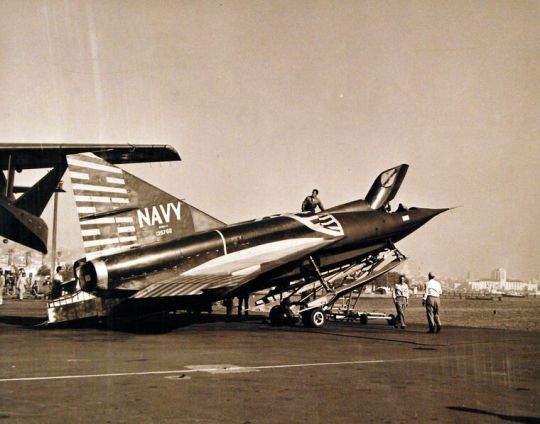
-One of the last photos of Convair pilot Charles Richbourg and the F2Y prior to their ill-fated flight. Photo: US Navy
Flights of the remaining Sea Darts continued, at a reduced tempo, until 1957 after which the aircraft were placed into storage. For this reason, the aircraft were still technically "on the books" in 1962 and were thus redesignated the YF-7A under the Tri-Service scheme, even though they had not flown for some 5 years. One XF2Y prototype and three YF2Y test aircraft survive, on display across the US:
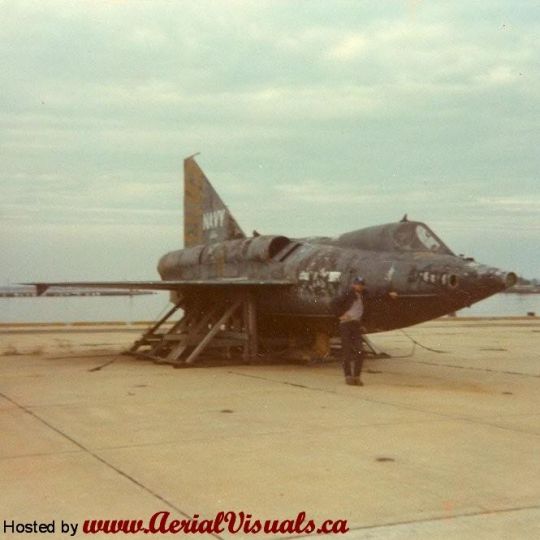
-XF2Y-1 Sea Dart, Bureau Number 137634, is in bad shape due to a mistake with a crane and is awaiting restoration for the Smithsonian Institution in Washington D.C..

-YF2Y-1 Sea Dart, Bureau Number 135763, is on display at the San Diego Air & Space Museum in Balboa Park.
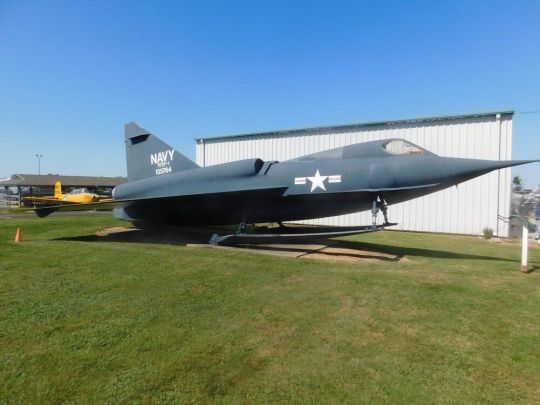
-YF2Y-1 Sea Dart, Bureau Number 135764, is on display at the Wings of Freedom Aviation Museum at NAS Willow Grove, Pennsylvania.

-YF2Y-1 Sea Dart, Bureau Number 135765, is on display at the Florida Air Museum
#aircraft#aviation#avgeek#cold war#airplanes#airplane#cold war history#coldwar#aviation history#navy#us navy#f2y#Convair f2y#Convair sea dart#sea dart#f2y sea dart#xf2y#yf2y#yf7a#yf 7a#Convair#seaplane#sea plane
69 notes
·
View notes
